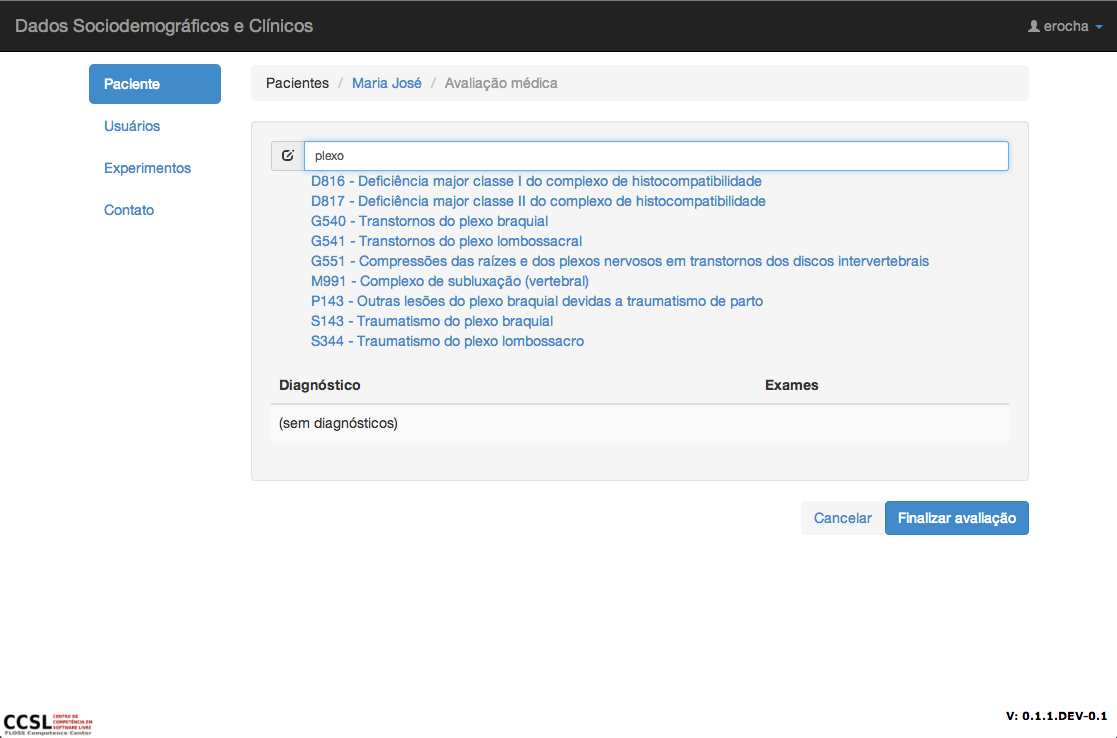
NeuroMat develops an open-source software for the management of neuroscience experimental data
Oct 31, 2014
The Research, Innovation and Dissemination Center for Neuromathematics (CEPID NeuroMat) software development team released in October the first module of Neuroscience Experiments System (NES), an open-source tool to manage clinical data gathered in hospitals and research institutions.
Neuroscience experiments gather different, numerous types of data from patients and volunteers -- such as exams, diagnoses, socioeconomic background, medical history -–, and it has become necessary both for physicians and scientists to have access to a system to recover data.
 |
The clinical and research team at the Institute of Neurology Deolindo Couto, from the Federal University of Rio de Janeiro (INDC/UFRJ), pioneered the use of NES and had an important role in the defining features of the software. The INDC remains a partner institution in NeuroMat’s enterprise to reach a theoretical model to the human brain.
The seven members of NeuroMat’s software development team responded to the need of the INDC team and expect to move beyond the use in this particular setting, according to Prof. Kelly Rosa Braghetto, a NeuroMat member and professor at the University of São Paulo (USP), who coordinated the project. “We aim to integrate a much larger variety of databases involved in an experiment, including Electroencephalography (EEG) registers, scientific protocols, machine configurations, in order to provide secure and open-access information.”
Prof. Braghetto’s understanding of the goal to move toward with NES relates to NeuroMat’s stand on promoting open data, that has been considered a key component in advancing clinical treatments and has led to innovative organizational designs among software-development team members.
Concerning the stand on open data, NeuroMat members claim that experimental data may be shared among researchers –- in a safe environment concerning volunteers’ privacy. Data-sharing remains relatively small in neuroscience, which has been identified as an obstacle to new studies and discoveries on neurons, their interaction, and the brain as a whole.
Next steps on the bettering of NES involve the development of new functionalities. In any case, the first module of the software is publicly available and may even be adapted to particular institutional needs.
Extreme programming
Some values guided NES development, which can be classified as using extreme programming techniques. With these methodologies, as stated by Evandro Santos Rocha, a NeuroMat team member, the software is tested and turns functional in a short amount of time. “In the classic way of producing systems, in general, more time is spent on the development, and, when the software is released, sometimes it does not meet expectations – what generates more costs. In extreme programing, we align demands and development more frequently, and as a result we reduce costs of implementation.”
As a positive collateral effect, this constant communication strengthens team bonds and reinforced the partnership between NeuroMat and the Institute of Neurology Deolindo Couto. At this moment, teams from the Institute are being trained to deal with NES and are expected to report on scholar venues their experiences.
Module details
Technically, the prioritized functionalities of the first module of NES were: i) patient registration, with social-demographic and social history information; ii) medical evaluation record, using the International Classification of Diseases (ICD) to register patients diagnosis; iii) simple experimental data management, interfacing the use of LimeSurvey, an application to handle electronic questionnaires (LimeSurvey information may be read here).
The team has the goal to develop four additional modules:
- Neuroimaging Data Acquisition
- Histopathology Data Acquisition
- Molecular Data Acquisition
- Derived Data and their Provenance Information
- For the modeling of these database modules, a new round of interactions and discussions among project members, in order to identify and characterize data that are worth storing, will be conducted.
Key facts
NES is an open-source software and its source-code is available on the NeuroMat github account: github.com/neuromat. Also, on the NeuroMat github repository one may found screenshots and a link to a step-by-step presentation.
This piece is part of NeuroMat's Newsletter #9. Read more here
Share on Twitter Share on Facebook| NeuroCineMat |
|---|
|
Featuring this week: |
| Newsletter |
|---|
|
Stay informed on our latest news! |
| Follow Us on Facebook |
|---|




